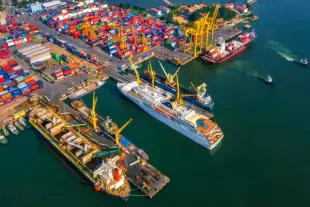Infrastructure
Vizhinjam Seaport Hosts India’s Largest Container Ship MSC Kayley, Ultra Large Vessel MSC Claude Girardet To Follow
V Bhagya Subhashini
Sep 11, 2024, 02:18 PM | Updated 02:17 PM IST
Save & read from anywhere!
Bookmark stories for easy access on any device or the Swarajya app.


Even before its official commissioning, Vizhinjam International Seaport has made a historic mark by welcoming the largest container ship ever to berth at an Indian port. The MSC Kayley, a massive vessel sailing under the Liberian flag, arrived at the port on Monday (10 September), marking a significant achievement for the seaport’s deep water capabilities.
The MSC Kayley has a draught of 16.5 metres, which is one of the deepest ever recorded for a ship docking at an Indian port. This monumental event is seen as a critical test of Vizhinjam’s natural depth advantage, which boasts a channel depth of up to 20 metres in certain areas without the need for extensive dredging.
Port authorities revealed that the draught of 16.5 metres reached by MSC Kayley is the second-highest draught for any vessel docking at an Indian port. The only ship to surpass this depth was another vessel from Mediterranean Shipping Company (MSC), which docked at Mundra Port in Gujarat with a draught of 17 metres.
"This is a record indeed," said Sreekumar K Nair, CEO of Vizhinjam International Seaport Ltd (VISL). "As far as I know, no other ship has docked at an Indian port with this much draught, confirming the port's unique capacity to handle ultra-large container vessels."
The MSC Kayley sailed smoothly into Vizhinjam and berthed at around 4 pm after arriving from Singapore. The ship measures 366 metres in length and 51 metres in width and was constructed in 2023, adding to its reputation as a modern giant of the seas.
Vizhinjam, located about 14 kilometres from Kerala's capital city of Thiruvananthapuram, has a natural depth of over 18 metres and is located hardly 10 nautical miles (18 km) from the international shipping route from West Asia, Africa, and Europe to the far eastern regions of the world.
The arrival of MSC Kayley underscores the growing importance of Vizhinjam as a major global transshipment hub. The port’s deep draft and proximity to major international shipping routes make it an attractive destination for Ultra Large Container Vessels (ULCVs). These ships, which can carry over 20,000 TEUs (twenty-foot equivalent units), are increasingly being used by global shipping lines to reduce costs and improve efficiency.
The available depth allows for smooth navigation even for ships of significant size, with areas of the channel reaching depths of 18.6 to 20 metres — ample space for large vessels with a UKC (under keel clearance) of just one metre.
In a sign of future growth, MSC, the world’s largest shipping line, is reportedly in discussions to become the anchor customer for the Vizhinjam Port. The negotiations between MSC and port operator Adani are ongoing, with plans for formal commissioning expected next month. This partnership would solidify Vizhinjam's place as a key player on the global maritime stage.
The Biggest Vessel Set to Arrive
The excitement around Vizhinjam doesn't stop here. The port is preparing to receive MSC Claude Girardet, a colossal container ship with a TEU capacity of 24,116, making it the largest ship ever to dock at an Indian port and one of the biggest in South Asia, according to The Hindu report.
This Ultra Large Container Vessel, currently sailing under the Liberian flag, is expected to arrive between 13 and 14 September, arriving from the transshipment hub of Tanjung Pelepas in Malaysia.
Measuring 400 metres in length and 61.5 metres in width, MSC Claude Girardet will surpass the previous record-holder, MSC Anna, which had a capacity of 19,462 TEUs. The vessel's immense capacity is enough to cover an area equal to four standard soccer fields. Not only will this be a record-breaking event for India, but it will also demonstrate the Vizhinjam Port's readiness to handle the world's largest vessels.
Ultra Large Vessels: The Future of Shipping
The rise of Ultra Large Container Vessels (ULCVs) is reshaping the global shipping industry, allowing companies to move more cargo with fewer trips, thereby reducing costs and carbon emissions. These vessels can carry over 240,000 tonnes of cargo in up to 25 layers, making them far more efficient than traditional container ships.
ULCVs, like the ones docking at Vizhinjam, are particularly important for transshipment hubs. Ports with deep draft capabilities, such as Vizhinjam, offer a crucial advantage in the logistics chain, enabling seamless operations for some of the world’s largest shipping lines.
Vizhinjam International Seaport’s ability to handle ships like the MSC Kayley and MSC Claude Girardet is a game-changer for India’s shipping industry. The natural depth of the port, combined with its strategic location on global trade routes, positions it as a future hub for transshipment in the Indian Ocean region.
V Bhagya Subhashini is a staff writer at Swarajya. She tracks infrastructure developments.





